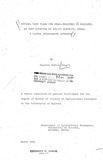| dc.description.abstract | This study examines the possibility of increasing farm income and resource use in Kaloleni location of Kilifi district. Many studies reviewed in the literature show that a potential exists for increasing net farm income and farm labour' employment in traditional agriculture through reorganisation of existing resources under existing and improved technologies. Specifically the study has the following objectives:
(1) to identify the critical factors constraining production in the farming system practised in
the area; ,
(2) to investigate the present resource allocation between the various farm enterprises (activities);
(3) to find farm systems that make the best use of resources and compare enterprises,and
finally;
(4) to examine the impact of the technical package of input recommendations under (IADP) in order to find out to what extent these can improve the use of resources, and hence increase net farm income.
Primary data used for analysis and programmlng was obtained by a farm survey conducted from November,1978, inclusive to end of January, 1979. The sample
frame was stratified on the basis of the Slze of small-holdings. The sample size of 30 small-holdings was proportionately distributed among the size groups.
Finally the ultimate sampling units were drawn randomly from each size group. The primary data was supplemented with secondary data collected from District Guidelines
and the Coast Agricultural Research Station, Mtwapa.
All the data collected refer to the 1978 agricultural year, which is the reference year of this study. Grossmargin analysis and linear programming (LP) techniques have been used in the study.
The analysis of the enterprises (activities) on the holdings show that the present net farm income of the small-holdings is between KShs.2461.40 and KShs.6509.20.
The analysis also shows a wide variation of gross--margins among the enterprises (activities). The cashewnut enterprise has the lowest gross-margin of KShs.680.00 per
ha while the coconut (wholenuts and toddy) enterprise has the highest gros s mergin of KSh.1820.20 per ha.The linear programming (LP) results show that there is an increasing net farm/income on all sizes of small holding in Kaloleni location through reorganisation of resources under both existing arid improved technologies. Introduction of improved technology however shows that net farm income and farm labour employment can even be increased more by this course of action than under existing technology .
The results of the study lead to the conclusion that a potential for increasing farm income and resource use exists in Kaloleni location. However, before planning techniques are applied and improved technologies introduced, some basic technical problems need to be solved, such as improving intercropping systems and determining efficient combinations of tree crops and tolerant cpops in the apea studied. Crop husbandry techniques need also to be improved through greater use of farm management extension: this is evident because of the low present net farm income situation. | en |

